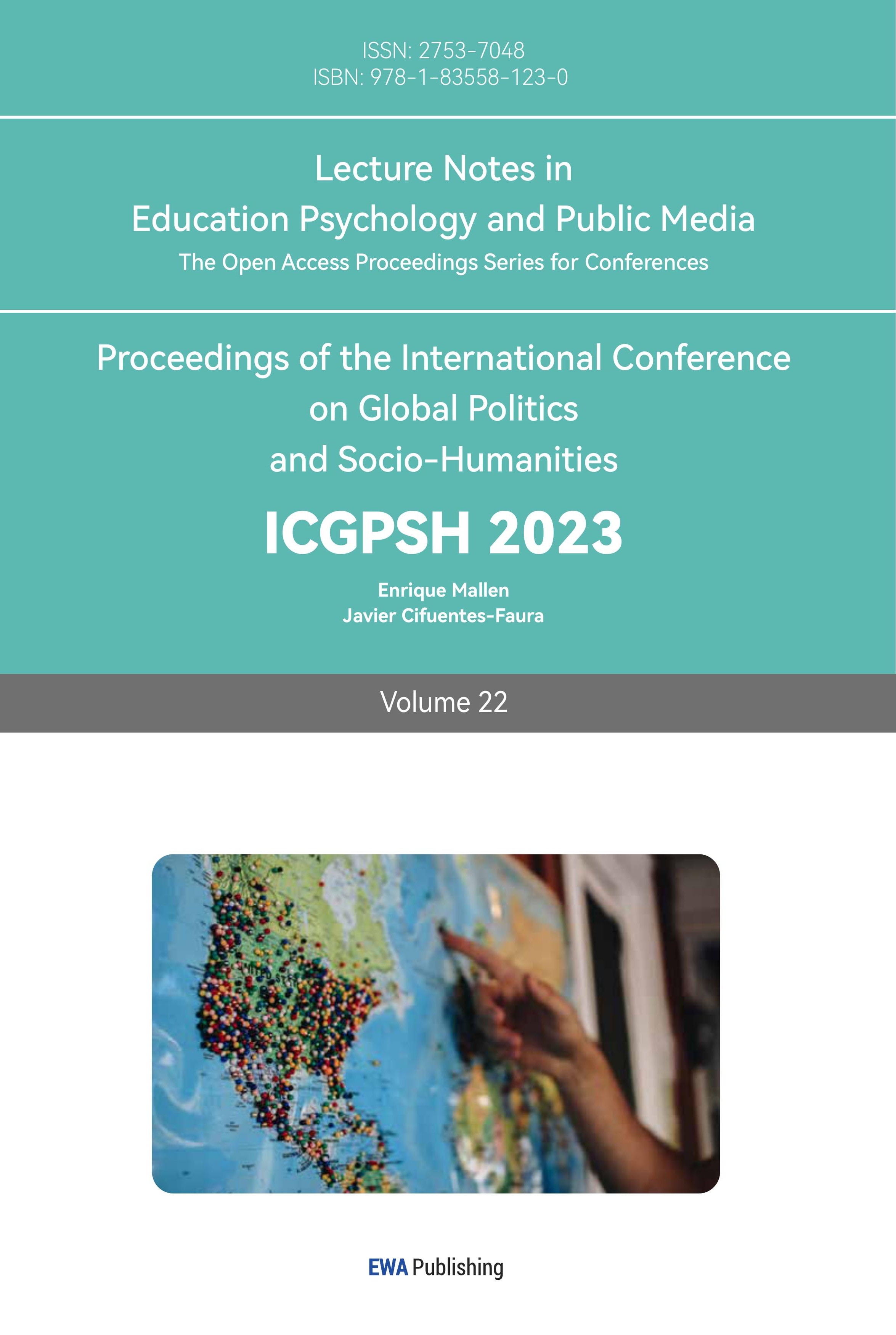References
[1]. Cheng, H. (2009). Inequality in basic education in China: A comprehensive review. International Journal of Educational Policies,3(2), 81-106.
[2]. Klees, S. J., & Qargha, O. (2014). Equity in education: The case of UNICEF and the need for participative debate. Prospects,44, 321-333.
[3]. Yue, C., & Xu, X. (2019). Review of quantitative methods used in Chinese educational research, 1978–2018.ECNU Review of Education,2(4), 515-543.
[4]. Zheng, T., Zhou, M., & He, Y. (2022, September). Regional Inequality of Higher Educational Resources’ Distribution in China. InProceedings of the 2022 International Conference on Business and Policy Studies (pp. 790-800). Singapore: Springer Nature Singapore.
[5]. Ming, H. H. (2013). The education of migrant children and China’s future: The urban left behind. Routledge.
[6]. Houxiong, W. (2011). Access to higher education in China: Differences in opportunity. Frontiers of Education in China,6(2), 227-247.
[7]. Chuanyou, B. (2006). Policies for compulsory education disparity between urban and rural areas in China.Frontiers of Education in China,1(1), 40-55.
[8]. Li, J., & Xue, E. (2022). Unpacking the Policies, Historical Stages, and Themes of the Education Equality for Educational Sustainable Development: Evidence fromChina.Sustainability,14(17), 10522.
[9]. Pan, L., & Ye, J. (2017). “Children of great development”: Difficulties in the education and development of rural left-behind children.Chinese Education & Society,50(4), 336-349.
[10]. Yuan, L., & Ding, Y. (2023). Poverty Alleviation Through Education: China’s Approach and Its Significance to the World. InThe Frontier of Education Reform and Development in China: Articles from Educational Research (pp. 339-365). Singapore: Springer Nature Singapore.
[11]. Tang, H., &Carr-Chellman, A. (2016). Massive Open Online Courses and educational equality in China: A qualitative inquiry.Journal of Educational Technology Development and Exchange (JETDE),9(1), 4.
Cite this article
Ge,J. (2023). The Fairness of School Education in China and Its Countermeasures. Lecture Notes in Education Psychology and Public Media,22,102-107.
Data availability
The datasets used and/or analyzed during the current study will be available from the authors upon reasonable request.
Disclaimer/Publisher's Note
The statements, opinions and data contained in all publications are solely those of the individual author(s) and contributor(s) and not of EWA Publishing and/or the editor(s). EWA Publishing and/or the editor(s) disclaim responsibility for any injury to people or property resulting from any ideas, methods, instructions or products referred to in the content.
About volume
Volume title: Proceedings of the International Conference on Global Politics and Socio-Humanities
© 2024 by the author(s). Licensee EWA Publishing, Oxford, UK. This article is an open access article distributed under the terms and
conditions of the Creative Commons Attribution (CC BY) license. Authors who
publish this series agree to the following terms:
1. Authors retain copyright and grant the series right of first publication with the work simultaneously licensed under a Creative Commons
Attribution License that allows others to share the work with an acknowledgment of the work's authorship and initial publication in this
series.
2. Authors are able to enter into separate, additional contractual arrangements for the non-exclusive distribution of the series's published
version of the work (e.g., post it to an institutional repository or publish it in a book), with an acknowledgment of its initial
publication in this series.
3. Authors are permitted and encouraged to post their work online (e.g., in institutional repositories or on their website) prior to and
during the submission process, as it can lead to productive exchanges, as well as earlier and greater citation of published work (See
Open access policy for details).
References
[1]. Cheng, H. (2009). Inequality in basic education in China: A comprehensive review. International Journal of Educational Policies,3(2), 81-106.
[2]. Klees, S. J., & Qargha, O. (2014). Equity in education: The case of UNICEF and the need for participative debate. Prospects,44, 321-333.
[3]. Yue, C., & Xu, X. (2019). Review of quantitative methods used in Chinese educational research, 1978–2018.ECNU Review of Education,2(4), 515-543.
[4]. Zheng, T., Zhou, M., & He, Y. (2022, September). Regional Inequality of Higher Educational Resources’ Distribution in China. InProceedings of the 2022 International Conference on Business and Policy Studies (pp. 790-800). Singapore: Springer Nature Singapore.
[5]. Ming, H. H. (2013). The education of migrant children and China’s future: The urban left behind. Routledge.
[6]. Houxiong, W. (2011). Access to higher education in China: Differences in opportunity. Frontiers of Education in China,6(2), 227-247.
[7]. Chuanyou, B. (2006). Policies for compulsory education disparity between urban and rural areas in China.Frontiers of Education in China,1(1), 40-55.
[8]. Li, J., & Xue, E. (2022). Unpacking the Policies, Historical Stages, and Themes of the Education Equality for Educational Sustainable Development: Evidence fromChina.Sustainability,14(17), 10522.
[9]. Pan, L., & Ye, J. (2017). “Children of great development”: Difficulties in the education and development of rural left-behind children.Chinese Education & Society,50(4), 336-349.
[10]. Yuan, L., & Ding, Y. (2023). Poverty Alleviation Through Education: China’s Approach and Its Significance to the World. InThe Frontier of Education Reform and Development in China: Articles from Educational Research (pp. 339-365). Singapore: Springer Nature Singapore.
[11]. Tang, H., &Carr-Chellman, A. (2016). Massive Open Online Courses and educational equality in China: A qualitative inquiry.Journal of Educational Technology Development and Exchange (JETDE),9(1), 4.









